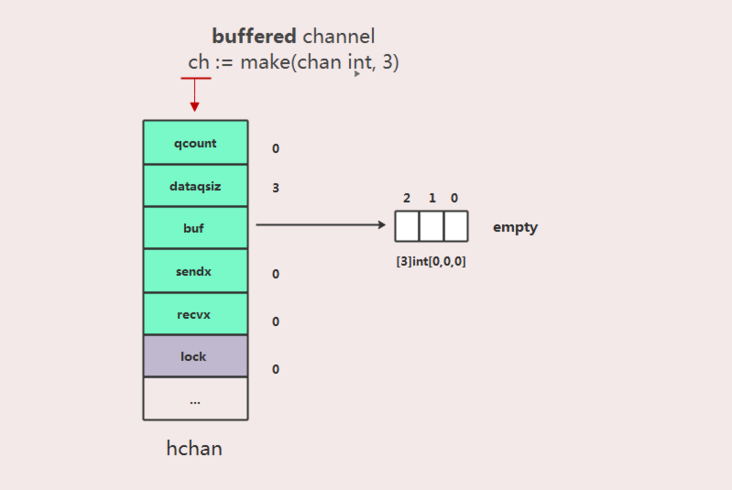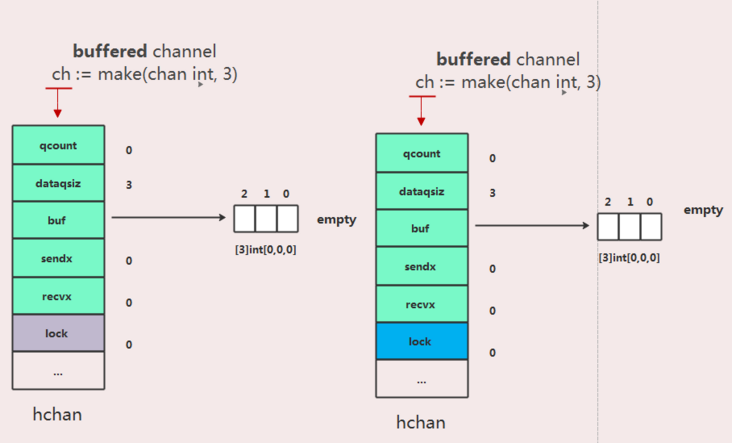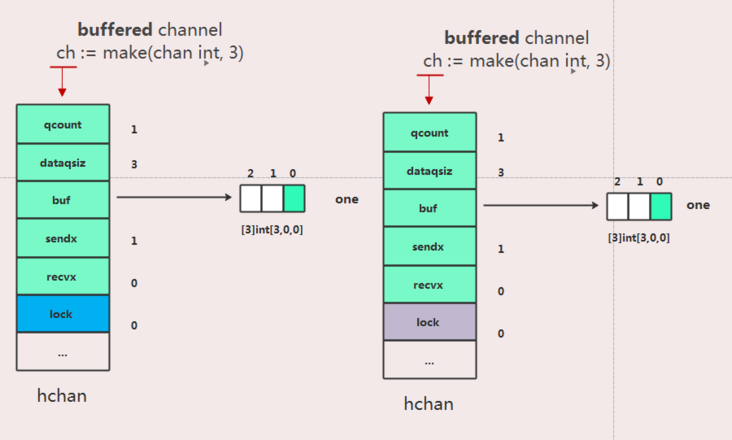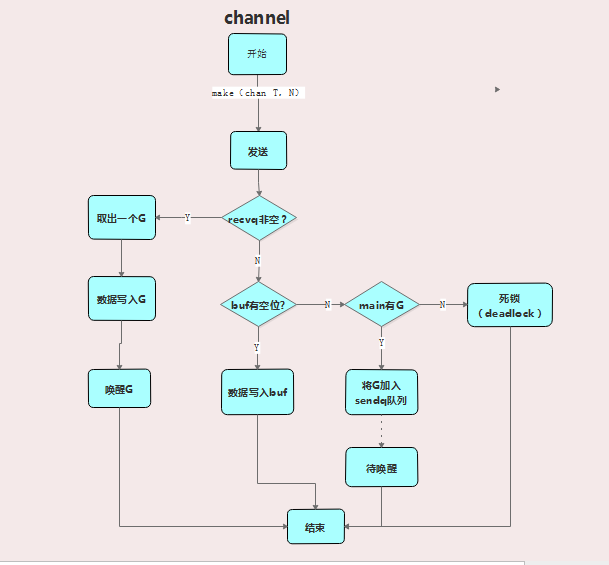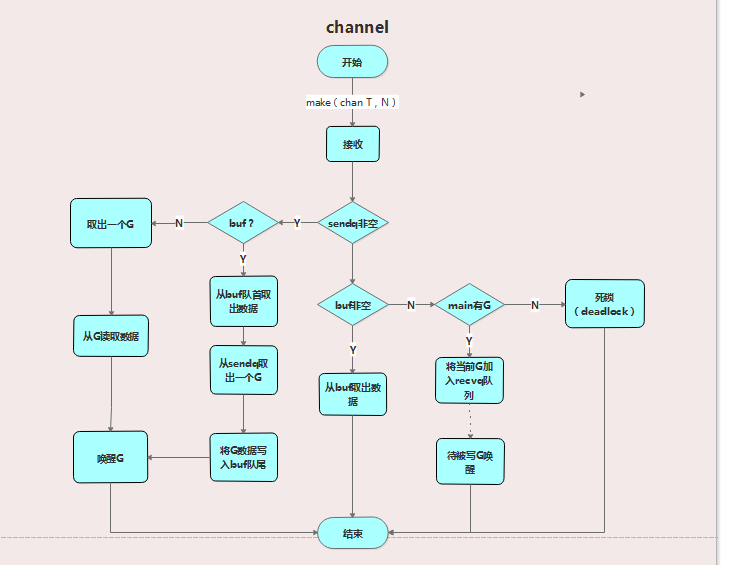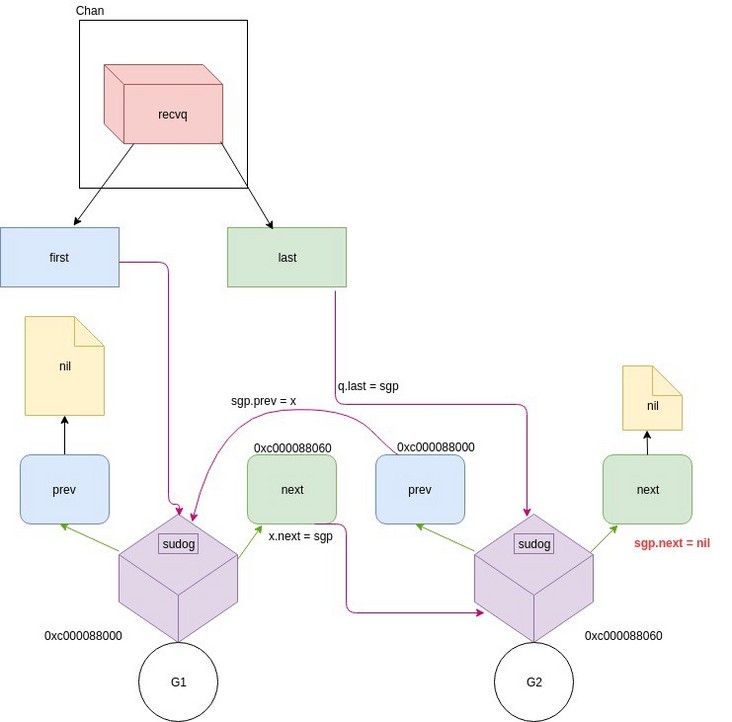
channel一个类型管道,通过它可以在goroutine之间发送和接收消息。它是Golang在语言层面提供的goroutine间的通信方式。
众所周知,Go依赖于称为CSP(Communicating Sequential Processes)的并发模型,通过Channel实现这种同步模式。Go并发的核心哲学是不要通过共享内存进行通信; 相反,通过沟通分享记忆。
下面以简单的示例来演示Go如何通过channel来实现通信。
package main
import (
"fmt"
"time"
)
func goRoutineA(a <-chan int) {
val := <-a
fmt.Println("goRoutineA received the data", val)
}
func goRoutineB(b chan int) {
val := <-b
fmt.Println("goRoutineB received the data", val)
}
func main() {
ch := make(chan int, 3)
go goRoutineA(ch)
go goRoutineB(ch)
ch <- 3
time.Sleep(time.Second * 1)
}
结果为:
goRoutineA received the data 3
上面只是个简单的例子,只输出goRoutineA ,没有执行goRoutineB,说明channel每次读写,仅允许被一个goroutine读写。
接下来我们通过源代码分析程序执行过程,在讲之前,如果不了解go 并发和调度相关知识。 请阅读这篇文章 Go goroutine理解
说道channel这里不得不提通道的结构hchan。
hchan
源代码在src/runtime/chan.go
type hchan struct {
qcount uint // total data in the queue
dataqsiz uint // size of the circular queue
buf unsafe.Pointer // points to an array of dataqsiz elements
elemsize uint16
closed uint32
elemtype *_type // element type
sendx uint // send index
recvx uint // receive index
recvq waitq // list of recv waiters
sendq waitq // list of send waiters
// lock protects all fields in hchan, as well as several
// fields in sudogs blocked on this channel.
//
// Do not change another G's status while holding this lock
// (in particular, do not ready a G), as this can deadlock
// with stack shrinking.
lock mutex
}
type waitq struct {
first *sudog
last *sudog
}
说明:
qcount uint // 当前队列中剩余元素个数
dataqsiz uint // 环形队列长度,即缓冲区的大小,即make(chan T,N),N.
buf unsafe.Pointer // 环形队列指针
elemsize uint16 // 每个元素的大小
closed uint32 // 表示当前通道是否处于关闭状态。创建通道后,该字段设置为0,即通道打开; 通过调用close将其设置为1,通道关闭。
elemtype *_type // 元素类型,用于数据传递过程中的赋值;
sendx uint和recvx uint是环形缓冲区的状态字段,它指示缓冲区的当前索引 - 支持数组,它可以从中发送数据和接收数据。
recvq waitq // 等待读消息的goroutine队列
sendq waitq // 等待写消息的goroutine队列
lock mutex // 互斥锁,为每个读写操作锁定通道,因为发送和接收必须是互斥操作。
这里sudog代表goroutine。
创建channel 有两种,一种是带缓冲的channel,一种是不带缓冲的channel
// 带缓冲
ch := make(chan Task, 3)
// 不带缓冲
ch := make(chan int)
这里我们先讨论带缓冲
ch := make(chan int, 3)
创建通道后的缓冲通道结构
hchan struct {
qcount uint : 0
dataqsiz uint : 3
buf unsafe.Pointer : 0xc00007e0e0
elemsize uint16 : 8
closed uint32 : 0
elemtype *runtime._type : &{
size:8
ptrdata:0
hash:4149441018
tflag:7
align:8
fieldalign:8
kind:130
alg:0x55cdf0
gcdata:0x4d61b4
str:1055
ptrToThis:45152
}
sendx uint : 0
recvx uint : 0
recvq runtime.waitq :
{first:<nil> last:<nil>}
sendq runtime.waitq :
{first:<nil> last:<nil>}
lock runtime.mutex :
{key:0}
}
源代码
func makechan(t *chantype, size int) *hchan {
elem := t.elem
...
}
如果我们创建一个带buffer的channel,底层的数据模型如下图:
向channel写入数据
ch <- 3
底层hchan数据流程如图
发送操作概要
1、锁定整个通道结构。
2、确定写入。尝试recvq从等待队列中等待goroutine,然后将元素直接写入goroutine。
3、如果recvq为Empty,则确定缓冲区是否可用。如果可用,从当前goroutine复制数据到缓冲区。
4、如果缓冲区已满,则要写入的元素将保存在当前正在执行的goroutine的结构中,并且当前goroutine将在sendq中排队并从运行时挂起。
5、写入完成释放锁。
这里我们要注意几个属性buf、sendx、lock的变化。
流程图
从channel读取操作
几乎和写入操作相同
代码
func goRoutineA(a <-chan int) {
val := <-a
fmt.Println("goRoutineA received the data", val)
}
底层hchan数据流程如图
这里我们要注意几个属性buf、sendx、recvx、lock的变化。
读取操作概要
1、先获取channel全局锁
2、尝试sendq从等待队列中获取等待的goroutine,
3、 如有等待的goroutine,没有缓冲区,取出goroutine并读取数据,然后唤醒这个goroutine,结束读取释放锁。
4、如有等待的goroutine,且有缓冲区(此时缓冲区已满),从缓冲区队首取出数据,再从sendq取出一个goroutine,将goroutine中的数据存入buf队尾,结束读取释放锁。
5、如没有等待的goroutine,且缓冲区有数据,直接读取缓冲区数据,结束读取释放锁。
6、如没有等待的goroutine,且没有缓冲区或缓冲区为空,将当前的goroutine加入recvq排队,进入睡眠,等待被写goroutine唤醒。结束读取释放锁。
流程图
recvq和sendq 结构
recvq和sendq基本上是链表,看起来基本如下
select
select就是用来监听和channel有关的IO操作,当 IO 操作发生时,触发相应的动作。
一个简单的示例如下
package main
import (
"fmt"
"time"
)
func goRoutineD(ch chan int, i int) {
time.Sleep(time.Second * 3)
ch <- i
}
func goRoutineE(chs chan string, i string) {
time.Sleep(time.Second * 3)
chs <- i
}
func main() {
ch := make(chan int, 5)
chs := make(chan string, 5)
go goRoutineD(ch, 5)
go goRoutineE(chs, "ok")
select {
case msg := <-ch:
fmt.Println(" received the data ", msg)
case msgs := <-chs:
fmt.Println(" received the data ", msgs)
default:
fmt.Println("no data received ")
time.Sleep(time.Second * 1)
}
}
运行程序,因为当前时间没有到3s,所以select 选择defult
no data received
修改程序,我们注释掉default,并多执行几次结果为
received the data 5
received the data ok
received the data ok
received the data ok
select语句会阻塞,直到监测到一个可以执行的IO操作为止,而这里goRoutineD和goRoutineE睡眠时间是相同的,都是3s,从输出可看出,从channel中读出数据的顺序是随机的。
再修改代码,goRoutineD睡眠时间改成4s
func goRoutineD(ch chan int, i int) {
time.Sleep(time.Second * 4)
ch <- i
}
此时会先执行goRoutineE,select 选择case msgs := <-chs。
range
可以持续从channel读取数据,一直到channel被关闭,当channel中没有数据时会阻塞当前goroutine,与读channel时阻塞处理机制一样。
package main
import (
"fmt"
"time"
)
func goRoutineD(ch chan int, i int) {
for i := 1; i <= 5; i++{
ch <- i
}
}
func chanRange(chanName chan int) {
for e := range chanName {
fmt.Printf("Get element from chan: %d\n", e)
if len(chanName) <= 0 { // 如果现有数据量为0,跳出循环
break
}
}
}
func main() {
ch := make(chan int, 5)
go goRoutineD(ch, 5)
chanRange(ch)
}
结果:
Get element from chan: 1
Get element from chan: 2
Get element from chan: 3
Get element from chan: 4
Get element from chan: 5
死锁(deadlock)
指两个或两个以上的协程的执行过程中,由于竞争资源或由于彼此通信而造成的一种阻塞的现象。
在非缓冲信道若发生只流入不流出,或只流出不流入,就会发生死锁。
下面是一些死锁的例子
1、
package main
func main() {
ch := make(chan int)
ch <- 3
}
上面情况,向非缓冲通道写数据会发生阻塞,导致死锁。解决办法创建缓冲区 ch := make(chan int,3)
2、
package main
import (
"fmt"
)
func main() {
ch := make(chan int)
fmt.Println(<-ch)
}
向非缓冲通道读取数据会发生阻塞,导致死锁。 解决办法开启缓冲区,先向channel写入数据。
3、
package main
func main() {
ch := make(chan int, 3)
ch <- 3
ch <- 4
ch <- 5
ch <- 6
}
写入数据超过缓冲区数量也会发生死锁。解决办法将写入数据取走。
死锁的情况有很多这里不再赘述。
还有一种情况,向关闭的channel写入数据,不会产生死锁,产生panic。
package main
func main() {
ch := make(chan int, 3)
ch <- 1
close(ch)
ch <- 2
}
解决办法别向关闭的channel写入数据。
参考:
https://codeburst.io/diving-d…

